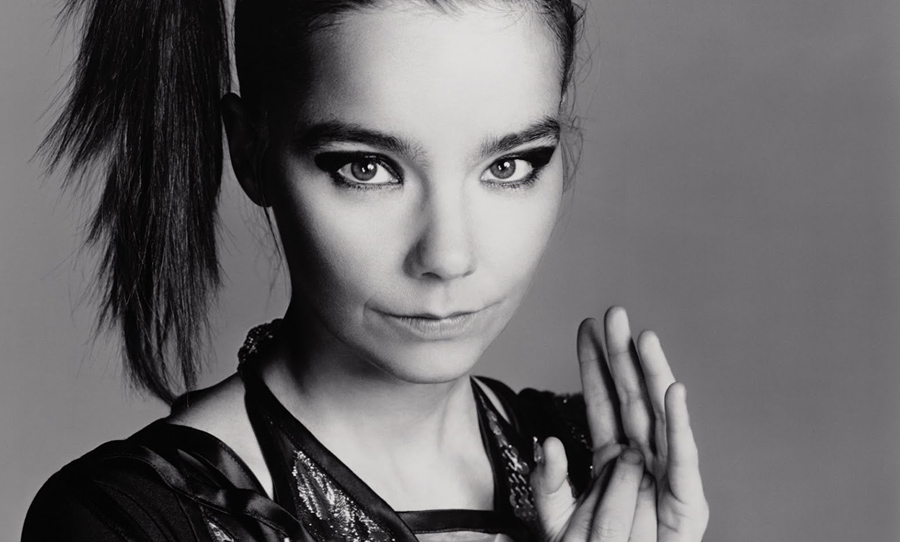Björk is a divergent icon, with no single genre capable of summing up her oeuvre. Medúlla is arguably her most daring body of work.
She is the eclectic visionary hailing from Iceland, known for her innocent-to-extreme-sounding vocals, ethereal echoes, and that iconic swan dress from the 73rd Academy Awards. Björk is unlike any other, with unrivalled artistry and innovation seeing the label of ‘pop star’ become hopelessly insubstantial when describing her incredible talent.
Known for her unique voice and style, Björk transitions between a three-octave vocal range as a mezzo-soprano, integrating electronic and organic sounds throughout her work. And as her music most frequently explores the relationship between nature and technology, Björk hypnotises with her celestial voice, making her one of the most recognisable living artists.
Medúlla, her fifth album, is the most extreme manifestation of Björk’s approach to songwriting and production. With myriad identities, its essence is distilled through the use of a single instrument: the human voice.
The beginnings of Björk
Born in 1965, Björk’s early life was spent in a commune in Reykjavík with her activist mother Hildur Rúna Hauksdóttir who protested against the development of Iceland’s Kárahnjúkar Hydropower Plant. Such influences gave way to Björk’s passion for the natural environment, a theme heavily explored throughout her work.
Due, in large part to this slightly unconventional upbringing, Björk channels this passion for the environment through her music, not only as a strongly referenced theme but as an active creator of sound. Björk transmits the movements of the Earth throughout songs like Náttúra, a track released in support of environmental preservation, whereby the listener is immediately captivated by the sounds of coastal winds and crashing waves.
Other influences include the likes of Joni Mitchell, whose angelic voice and wisdom encouraged Björk to write her own lyrics and fuel her songs with female emotion, energy and imagination, creating a musical universe that became boundless and liberating.
However, it was her participation in a school recital where she sang Tina Charles’ 1976 hit I Love to Love that defined her prodigious nature. Teachers at the school sent a recording of her performance to the RÚV radio station, which was at that point Iceland’s only radio station. It was played across the country and gained Björk her first recording contract.
In 1986 Björk formed the Icelandic alternative rock band The Sugarcubes, becoming the vocalist and keyboardist. They were considered the first band from Iceland to receive international acclaim and have a global impact, yet after producing only two albums they split in 1992 with Björk going on to follow a solo career.
The masterpiece of Medúlla
Throughout her endlessly creative career, spanning over four decades, Björk has transcended the labels of singer, composer, actress and fashion icon to be a breaker of any and all boundaries presented to her. Medúlla only cemented this identity.
Curated almost entirely out of human vocals, it was the album that gave way to Björk’s full range of artistic capabilities, championing a sonic journey that integrated the sounds of rock, beatboxing and traditional Inuit throat singing.
Released in 2004, Medúlla swiftly gauged Björk’s trans-disciplinary approach to composing and producing work, setting her apart from her previously recognised status predominantly in the electronic music scene.
Work on the album began in 2002, marking Björk’s turn away from machine constructed sound, championing the natural vocals of a variety of different artists. For Björk, it was a journey connected to the carefree nature of her teenage life, elements of life, love, family and friends at the crux of the musical narrative being showcased throughout.
Medúlla, deriving from the Latin term Marrow became indicative of the raw and bare musical essence of voice-based work, a comment on the human soul and a reaction to the post 9/11 political climate and interactions that Björk deemed consequential to society’s involvement with polarising social constructs.
She told The Guardian back in 2005, “What about the human soul? What happened before we got involved in problematic things like civilization and religion and nationhood?”.
Self-produced, Medúlla‘s release was concurrent with the changing social dynamics of the world and features an eclectic cast of musicians spanning across the full spectrum of musical genres. The multi-tracked vocal format was outrageously distinct from Björk’s critically acclaimed and die-hard pleasing Vespertine, the album’s predecessor.
And that’s why Medúlla matters, it was a record constructed on the basis of an A Cappella journey that linked some of the most distinct and far-reaching vocals and represented a huge risk from the notoriously experimental Icelandic export. A grouping of some of the music industry’s brightest, the album encompasses the works of The Roots’ Rahzel, Japanese beat-boxer Dokaka, American metal-singer and composer Mike Patton, Inuit throat singer Tanya Tagaq and English pop icon Robert Wyatt.
Opening the album is Pleasure is All Mine, which captivates immediately with the blending of eerie hums, rhythmic, short, sharp inhalations and exhalations of traditional throat singing and layered with the crisp control of seasoned beat-boxing.
When listening it’s hard to fathom that every sound is organically human and without the aid of instruments.
As the album progresses the narrative is similar, yet different voices are championed throughout the variety of songs. Where Is The Line features greater ethereal choral arrangements and Patton’s recognisable growl, whilst Who Is It? champions Björk’s swooping soprano talent alongside Rahzel’s jackhammer rhythms.
An atmospheric masterpiece that centres the listener into a realm somewhat removed from reality, Medúlla received critical acclaim and was well-received by fans internationally. Critics called it brave and unique, extreme and yet highly accessible, whilst its commercial success saw it reach number one in Belgium’s Wallonia, France and Iceland, top ten in the UK, and garner two nominations at the 47th Grammy awards.
Ultimately Medúlla was a feat allowing Björk to challenge the capabilities of the human voice, the overuse of mechanical instruments, and electronically manipulated sound. An album unique in its own right and one that will continue to go unrivalled in its innovation and delivery.



